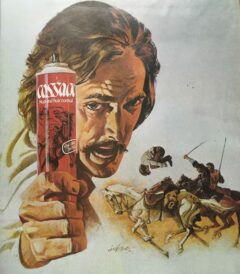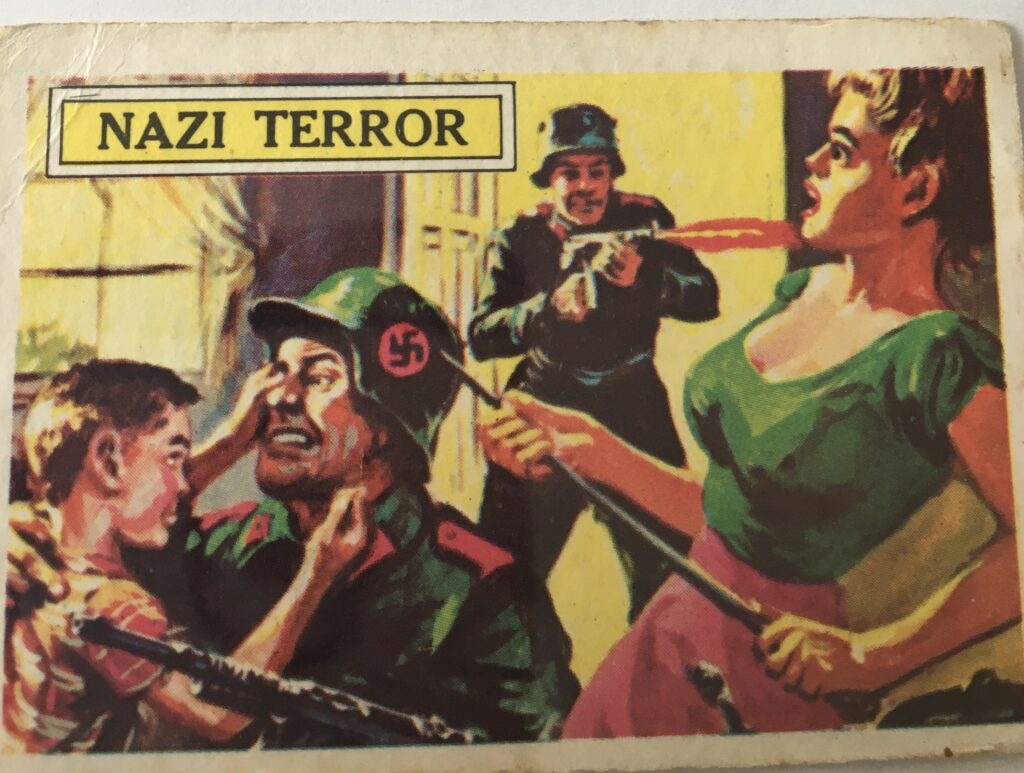
60s children’s trading cards didn’t sugar the pill about the horrors of war. And as 5-year-olds didn’t we just love them for it….
In the early 70s there was an ongoing, in fact it’s still going on, debate about the effect of TV and film violence on societal behaviour. It’s fair to say the jury is still out on that, and probably always will be, but the treatment given to films like A Clockwork Orange (see article below) was hugely disproportionate to its influence and its intentions.
It wasn’t always the case though as the sixties were a very different time. A flash of cleavage, a mild swear word or the whiff of marijuana and a film was strictly off limits to the young and impressionable. Even Dracula and Frankenstein films had an’X’ certificate slapped on them as young people could easily have their little heads turned by such horror. Or so it was thought. But primary school children could still get their fix of ultra-violence at the local newsagent and tobacconist for 5 old pennies courtesy of the good people at A, B and C trading cards.
All this talk of censorship and the effects of violence on society is really just a way of introducing what were the most violent, grisly, visceral and completely inappropriate trading cards ever released for children. And, as far as I can remember, no adult batted an eyelid, turned a hair or cried foul during the years that the wonderful Civil War News and Battle trading cards were available to any child who just happened to have 5 old pennies in his pockets.
Between 1964 and 1965, on my journey to Balgreen Primary School in Edinburgh I would stop off at the paper shop on the way and buy one, sometimes two, packets of either Civil War or Battle cards. In each pack there were five cards and a small rectangle of sugary pink bubblegum. There was a palpable feeling of excitement as you flicked through the pile of cards to see if you’d managed to secure at least one you didn’t already have. On reaching the school playground small groups of boys, it was always boys, girls didn’t collect them, huddled round as one member of the group flicked through his huge pile of cards and another boy would use the agreed code, ‘Got, got, got, no-got, no-got..’ At the end of this ritual intense negotiations would take place. If it was a hard-to-get card that could mean a 2 or even 3 to 1 trade of less sought after cards.
If my memory serves me, the Civil War News cards were released a year before the Battle cards. Each card featured a vividly coloured scene form the American Civil War with the date it took place and a title. The back of the card gave more details of the event in the form of a newspaper front page, sometimes being at odds with the images represented on the front. But we weren’t interested in the information anyway. It was really just the often exaggerated depictions of violence we wanted to see. If you were particularly lucky some packs of Civil War News included a facsimile of Confederate dollars, 17 of which could also be collected. These were less sought after though. It was really about the cards.
If those cards were made available to children today it would be tabloid front page news. But we loved them, nobody seemed that bothered and it didn’t turn us into a generation of serial killers. In my case, quite the opposite. To see the cards now, though, is quite a shocking experience but one that needs to be tempered by the fact that as children we knew these depictions of violence were purely comic book and the images were reflected in the children’s comics of the day. But more on those later.
So sit back and enjoy, if that’s the right word, a selection of the most gloriously perverse and inappropriate amusements ever produced for children. And try not to have nightmares.
Civil War News 1964
1. Death At Sea
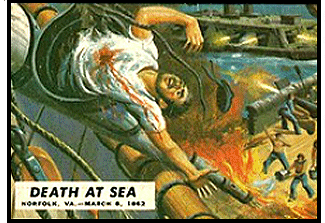
In a very nicely framed scene from a dizzying angle we see some poor dead schlub tangled in the rigging of a clipper while being attacked by, what looks like an enemy armoured ship. The wound in the centre of his chest shows he didn’t stand a chance. We see his shipmates trying to put out fires below and firing back at the attacking vessel, unlikely to have any effect on the heavily fortified attacking ship. Why the focus of the scene is this poor guy hanging from the rigging is uncertain, other than it will have excited young schoolboys.
2. Savages Attack
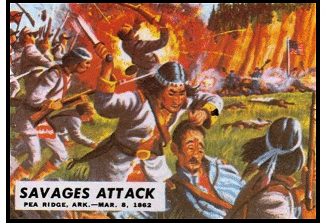
This was a bit of a curiosity for early 60s schoolboys. We all knew about Indians (as we referred to them then), there were plenty western series on telly at the time, but found it difficult to reconcile them with the American Civil War. Of course, Westerns inhabited a timeless period in American history. We had no idea when these events might have taken place or even if they had, but here’s some Indians (or ‘Savages‘ as the card sympathetically describes them in true 60s style) attacking unspecified troops and about to scalp them in true stereotypical fashion. According to the information on the back of the card, both Confederate and Unionist forces used Indians to supplement their numbers and they brought their own brand of combat to the conflict. At least according to the artist.
3. Painful Death
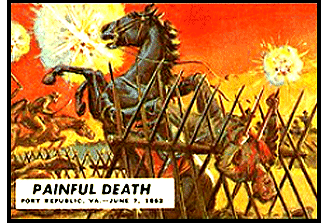
Talk about the bleedin’ obvious! Now ‘Painful Death‘ was a great favourite. Not only because of the vividness of the background battle scene but the sheer visceral violence of the foreground. The artist has certainly gone overboard with the reds and yellows in his palette and the blood gushing from the horseman’s wounds shows up vividly against the yellow background. And it sure does look like a painful death, and there were plenty more where that came from.
4. Crushed By Wheels
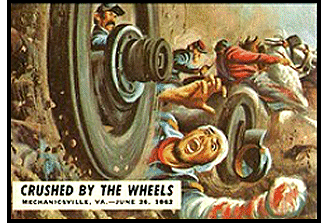
Not all the cards depicted violence of the most bloody kind, however. Some just suggested violence of the most bloody kind. And ‘Crushed By Wheels‘ was a personal favourite depicting potential carnage. The fact that this poor guy has already been through the wars and the anticipation on his face as he realises he is going to be flattened by a massive cannon wheel shows there is no luck in war. Interestingly, the story on the back of the card makes no reference to this unfortunate individual. It just looked good. Some superb art work here, you have to say.
5. Pushed To His Doom
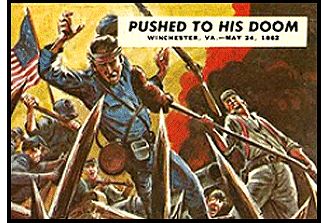
Like ‘Crushed By Wheels‘, ‘Pushed To His Doom‘ was of a similar type, merely suggesting a nasty end to one of the participants. Those finely sharpened spikes do not look welcoming and the look of sheer hostility on the face of the cannon-loader really made this card stand out. It makes an interesting companion piece to ‘Painful Death‘ as a before and after sequence. If you want to be artistic about it…..
6. Massacre!
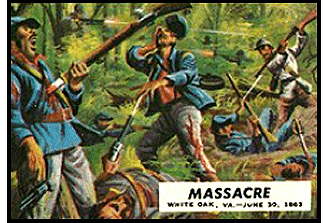
This example does what it says on the card. There’s probably more violence per centimetre than on any other card in the collection. The artist has certainly been creative when told to represent ‘a general slaughter.’ It reminds me a bit of the Monty Python ‘Salad Days‘ sketch. If the five-year-old child wanted value for his 5 old pennies, this is the card that certainly gives it in spade loads. However, I don’t remember ‘Massacre‘ being a favourite. By this time we were probably growing immune to indiscriminate carnage.
7. Death Barges In
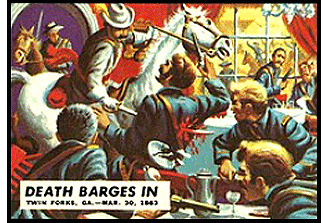
This one is particularly dramatic. One does wonder how the horsmen could have ridden into what looks like a hotel or restaurant without some opposition and brutally slay one of the Unionists. The artist has made sure the sword entering him is right in the middle of the picture to emphasise the ruthlessness and bloody murderousness of the attack. There’s a lot of bright red blood coming from that wound!
8. Angel Of Mercy
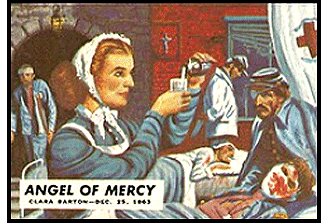
Occasionally, the cards attempted to show the more merciful side of warfare and the heroic efforts of people, usually women, who tended to the wounded and dying. But the artists couldn’t run the risk of completely disappointing their clients and so even in this heart-warming scene we have a man with a shockingly nasty face injury and blood seeping from the wound. They knew their audience…..
9. Attacked From Behind
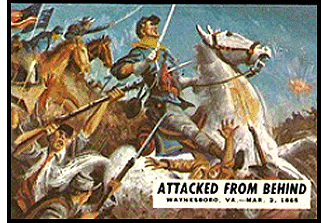
First law of combat. Don’t turn your back on the enemy! He’ll not do that again….
10. The Looters
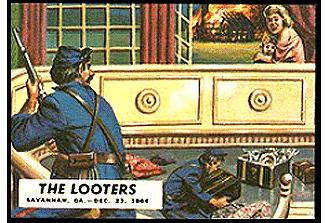
War is hell and no one is safe from the consequences. Some of the cards created scenarios that depicted this. As one soldier grabs the swag the other moves threateningly towards the innocent and vulnerable mother and child. What’s going to happen here? As five year olds we just thought it would end in some nasty comic book violence. As adults we’d prefer not to speculate…
11. Flaming Death
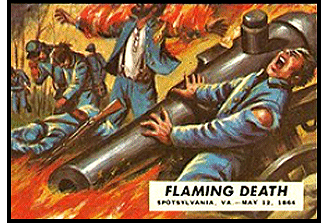
Oh look. A man in flames. Well, it makes a change from endless buckets of blood. Is he the Angel of Death? Maybe we were missing much of the imagery of these cards but probably not. It seems the only flammable part of his anatomy are his arms. Is that a good or a bad thing? You decide.
Well, they didn’t do me any harm. I think. But if you thought Civil War News cards were a one-off, you’d be wrong. If the manufacturers, the good people at A, B and C, thought children had been overexposed to such visceral bloodshed, butchery and carnage, well, that was only the amuse-bouche. The main course of gratuitous slaughter was about to be served, with a generous side order of ……sexual violence! Introducing Battle trading cards...
Battle! 1965
1. Fight To The Death
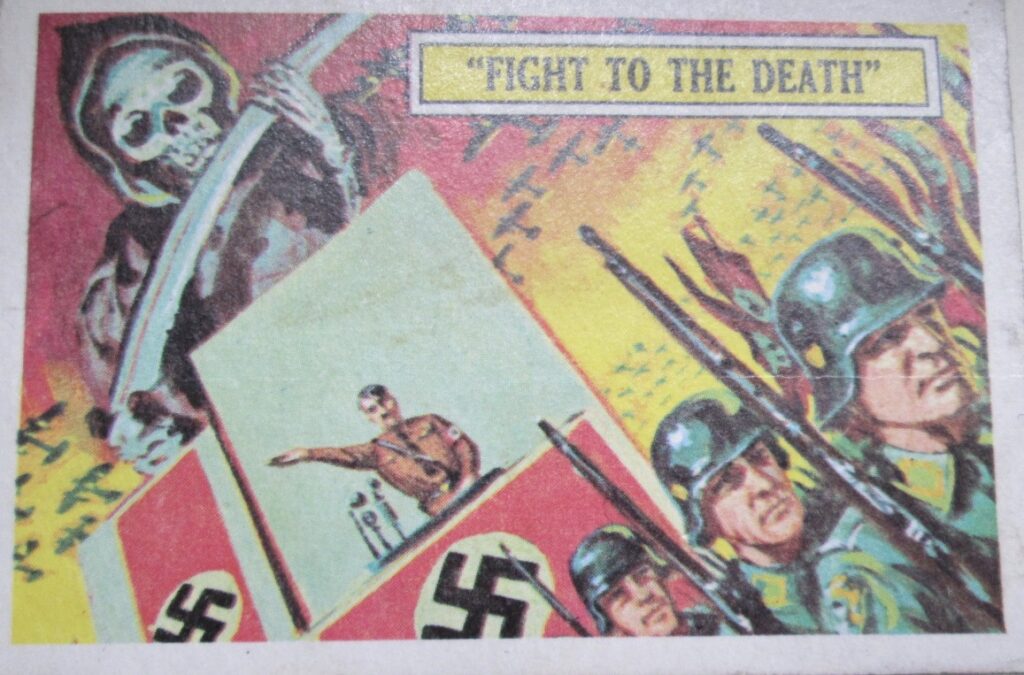
It all started off so well with this excellent montage of sickening Nazism and imagery, even including The Grim Reaper! This was a very sought after card. Not only was it Number 1 but it was packed with interesting detail. Maybe lacking in savage violence for the 6 year old taste, but what it lacked in carnage it made up for in World War 2 symbolism. It was vital that this was part of your collection and no one was going to swap this in a hurry!
2. Ambushing The General
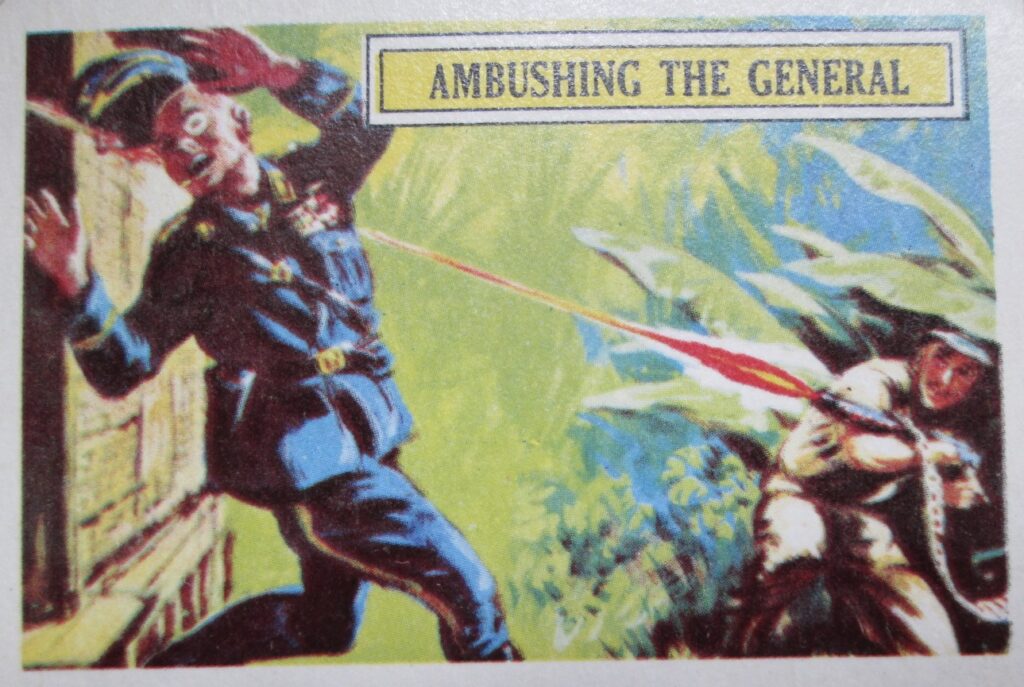
Now this is more like it. Not only is this nasty German general being slain but just look at the pompous, strutting popinjay, with his fancy uniform and stereotypical monocle. He could be a character from ‘Allo ‘Allo with a name like Von Sauerkraut or something but, if we follow the trajectory of that bullet straight through his heart, his Nazi days are most certainly over. And good riddance!
3. Fiery Death
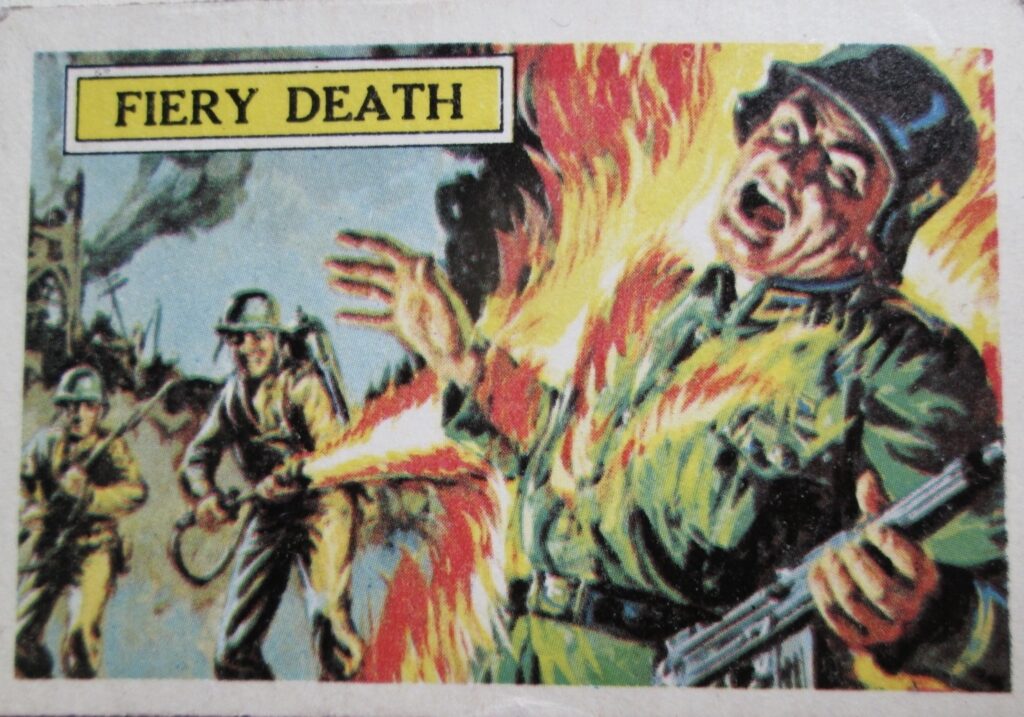
But let’s ramp up the violence a little, thinks the artist. If you thought shooting Germans with a gun was a little passe, it’s much more fun to do so with a flame thrower. One does wonder why these Allied soldiers decided to go with the flame thrower rather than the tried and tested rifle, which one of them is toting. Makes for a much more exciting card though. Eat flame, Fritz!
4. Dog Warrior
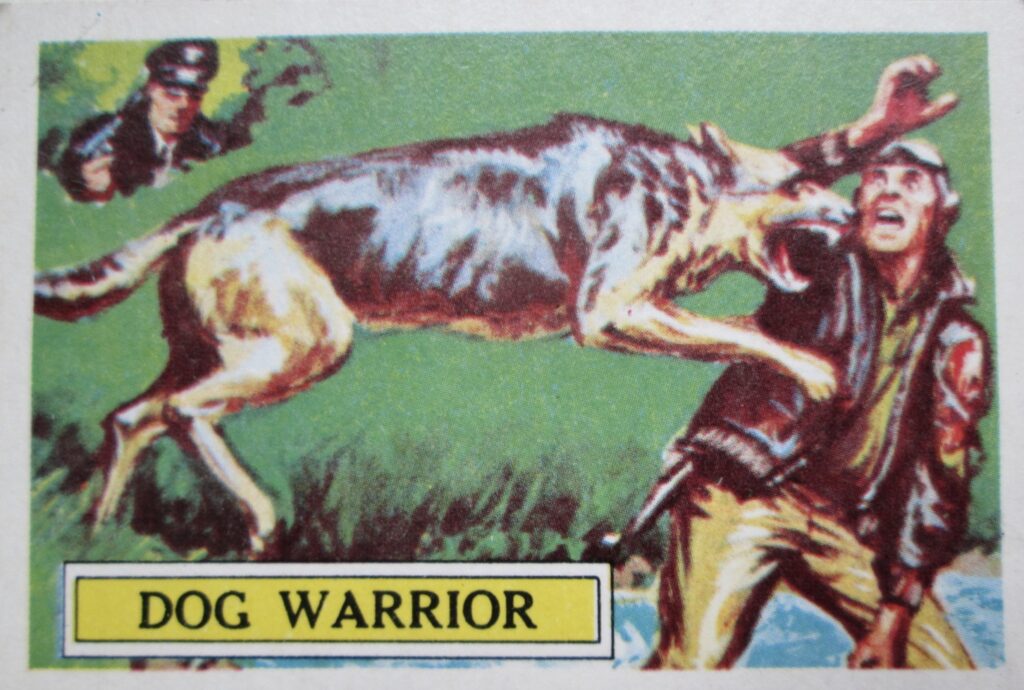
Ok, a flame thrower is one thing, but let’s not get nasty! And just look at that grinning Jerry hiding behind the bush. The artist has frozen the action at the point of impact. No doubt that Alsatian has been taught to do unspeakable things by the Jerries, and the artist has left you to come to your own 6 year-old conclusions.
5. School Bombing
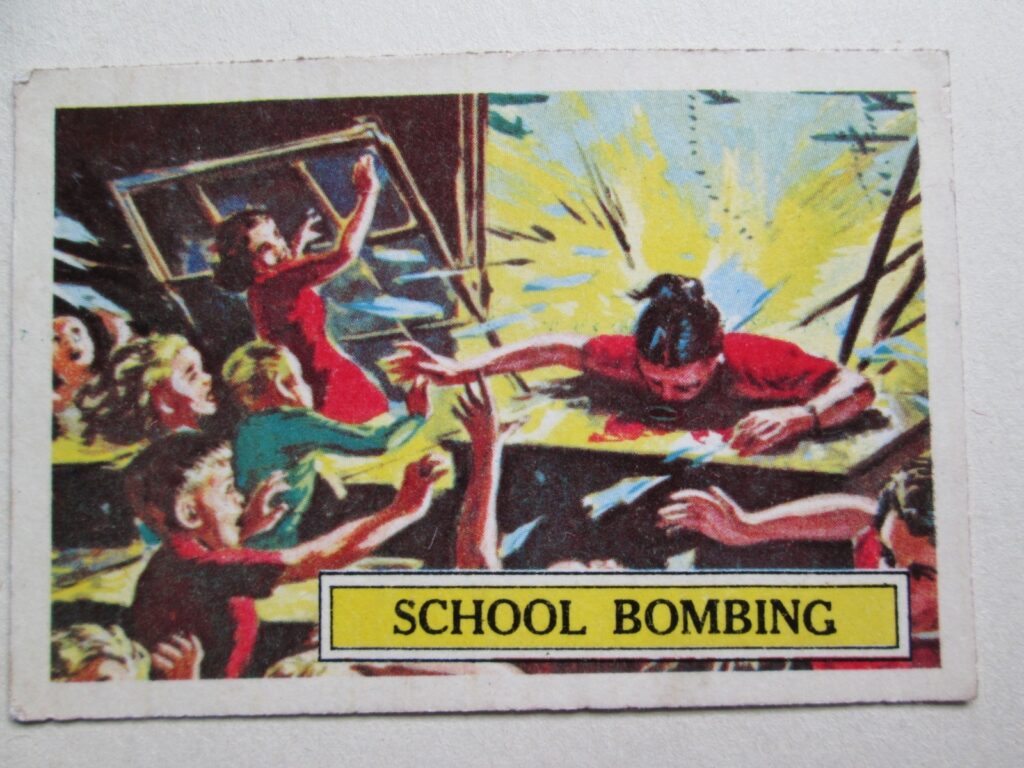
They’re at it again! Is nothing sacred? Those Jerries stop at nothing! To sell images of a school being bombed to 6 year old children on their way to school seems a touch insensitive. And to depict a teacher and primary age children being blown to bits also seems a little heartless. But war is hell and maybe that’s the message. Nice that they’ve included a bit of obligatory blood on the teacher’s table. But these are Battle cards for god’s sake, they’ve got to have some blood.
6. Death Blow
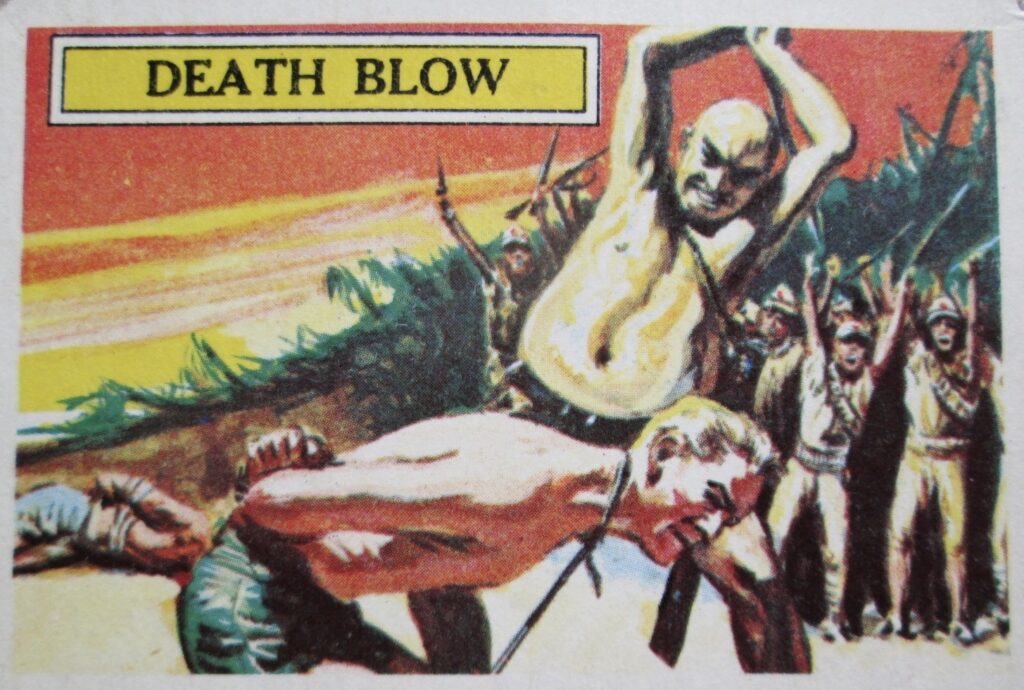
Oo-er! It wasn’t just the nasty Jerries we were up against, it was those just-as-nasty Japs too. And here we have an execution scene, well, 6 years olds need to know about these things. In 1965 the death penalty had just been scrapped in the UK so death had been all around. Look at those Japs in the background cheering, though, and the look of deep joy on the fat balding executioner’s face. The artist has spared us the view of the blade about to come crashing down, so he wasn’t completely heartless….. And even more sinister is the body of another prisoner whose head is obscured by the prisoner in the foreground, probably because he has already been decapitated. Charming.
7. The Torture Chamber
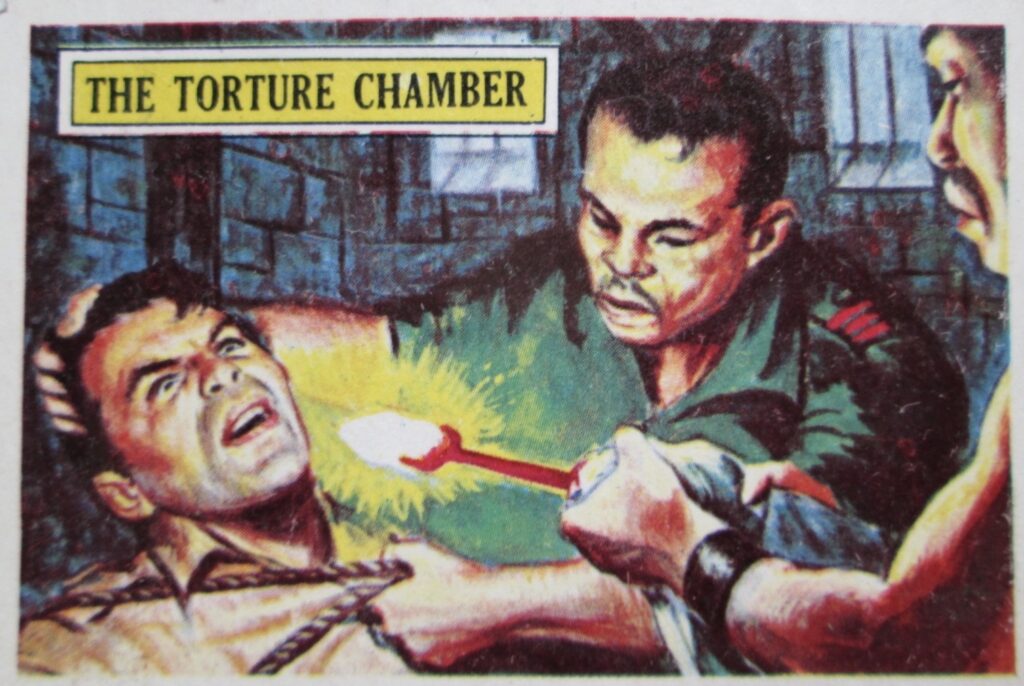
Well at least this guy is only being tortured! But not in a nice way. It’s all in a day’s work to the moustachioed taciturn Japs. They look as if their leader, Fu Man Chu, is about to step out of the shadows. And if you think this is rather near the knuckle…..
8. Flames Of Death
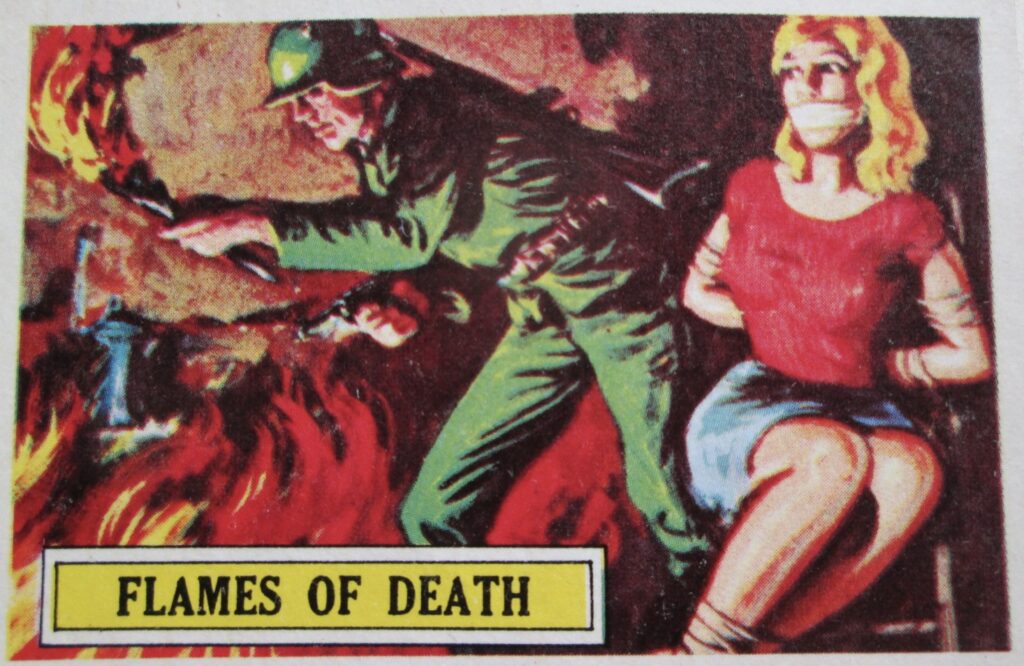
..what exactly is going on here? A young blonde woman with tight fitting clothing is tied up while a nasty German sets fire to her house. Why is she tied up I wonder and why is he setting fire to the house? Curious. But remember what I was saying about sexual violence…?
9. Beautiful Spy
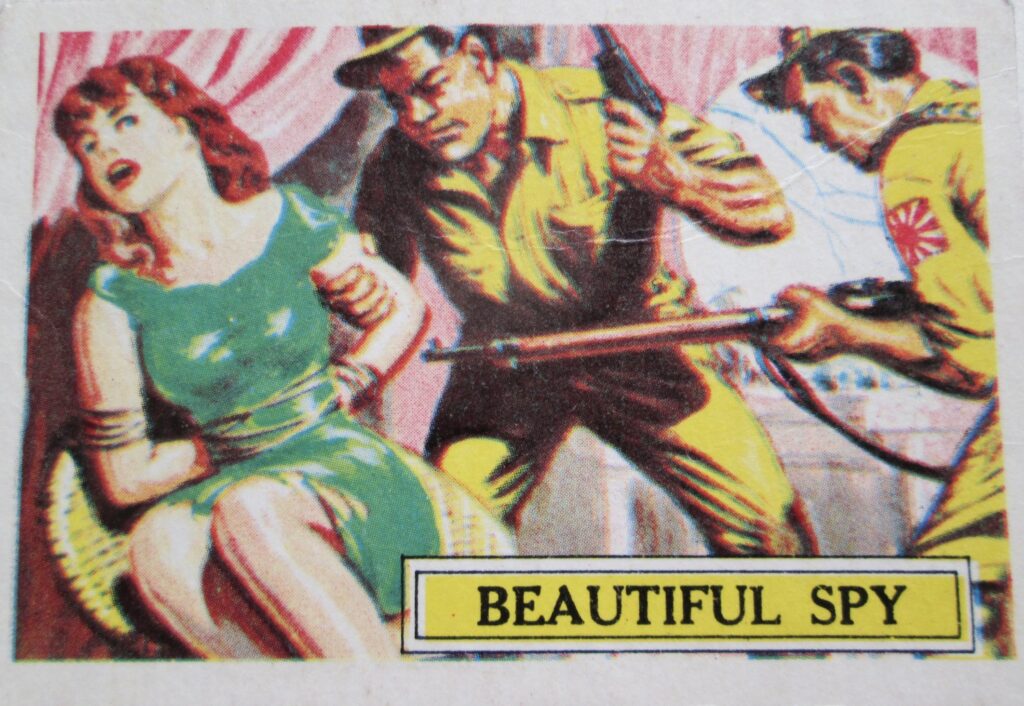
What is it with these artists and trussed up young attractive women? Note the similar way she is tied to the blonde woman above. There’s something decidedly odd going on here and 6 year olds were probably not the best group to notice. And these Japs do not seem to be observing The Geneva Convention to me.
10. Confession By Force
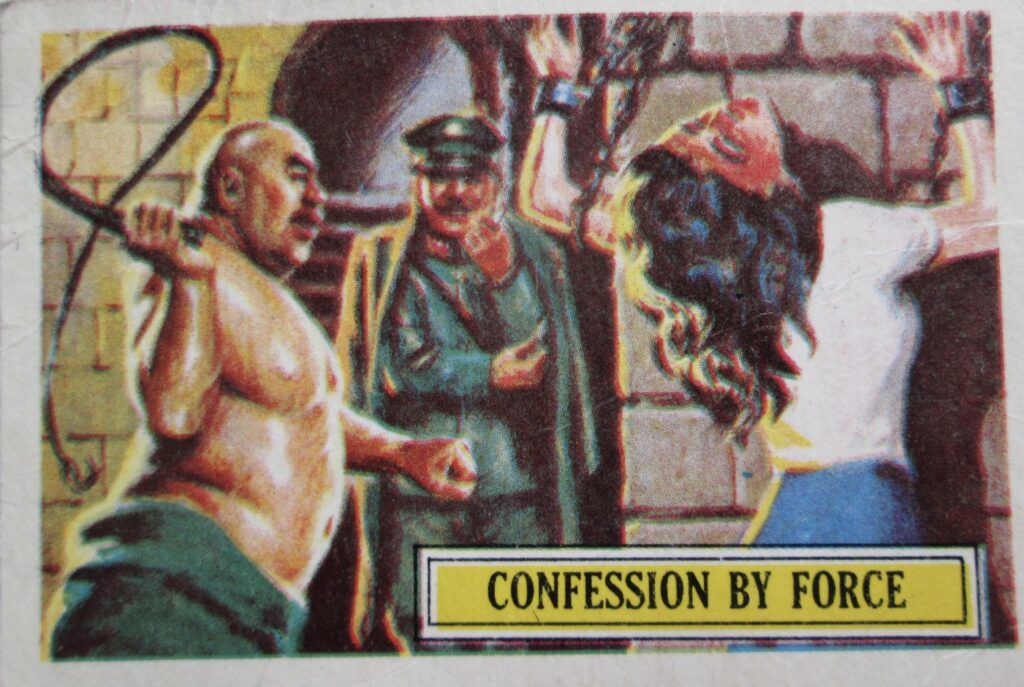
Now what’s going on here? Whatever it is, the grinning operative at the back seems to be enjoying it. We also have the obligatory balding, overweight torturer taking a little too much pride in his work. What, exactly, has this to do with the Second World War and why is it considered worthy of inclusion in a child’s set of trading cards? Hmmmm. Many years later someone would come up with the description ‘Torture Porn’ and films such as Saw became very lucrative. It became very popular in the 90s, so these cards were way ahead of their time you could say.
Although only a small selection of both card collections, these give a pretty good idea of what they were all about. I can’t help feeling like a slightly down market pornographer by featuring these images in my blog but for some people of a certain age these trading cards were a particularly memorable part of our formative years. None of us really had any idea of what was really going on in them. We didn’t know we were just a conduit for the artists’ darker pre-internet fantasies but looking at them now, one can’t help but think that had those cards been published for adults a few eyebrows may have been raised. Despite the controversial subject matter, we loved these cards. And I didn’t grow up hating Germans or the Japanese, or any other nationalities for that matter. What it does remind you of was the incessant violent images that were circulated in trading cards, comics and TV programmes, all aimed at young kids during the 60s and 70s. Of course the war had only ended less than 20 years previously, so for many people, it was a living memory.
In subsequent years cards became much more innocent and football players, Batman (hugely popular in 1966) and various other film themes replaced the blood-lust of Civil War and Battle. They were good but not quite the same.
I just wonder how I, and so many people of my age, grew up so well adjusted, but we did, as far as I know.
And I still have no desire to see films with explosions.
Postscript: The good people at the wonderful Talking Pictures TV broadcast How I Won The War a few nights ago. Made in 1967 starring Michael Crawford and a very young John Lennon in his first and only ‘serious’ role, it was directed by young radical up-and-coming director Dick Lester who would soon direct two of The Beatles‘ films. A few scenes show the characters swapping ‘Battle‘ cards. Fancy that! More to come on this very strange and interesting film at Genxculture.com
